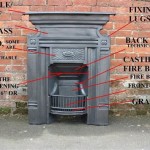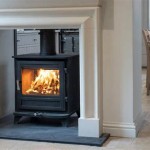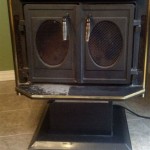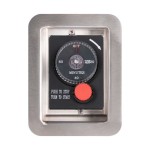Simple Fireplace Mantel Ideas for Every Home
The fireplace, often the heart of the home, serves as a focal point, radiating warmth and comfort. The mantel, situated above or around the fireplace opening, provides a prime opportunity to enhance the aesthetic appeal of this central architectural feature. While elaborate designs might appeal to some, a simple fireplace mantel can be equally impactful, offering a clean, understated elegance that complements a wide range of interior design styles. Simplicity in mantel design allows the fireplace itself to take center stage, while providing a functional surface for displaying cherished objects and seasonal décor.
This article explores various approaches to achieving a simple yet stylish fireplace mantel. Considerations include material selection, design styles, decorative accessories, and methods for updating an existing mantel. By focusing on clean lines, thoughtful detailing, and a curated selection of embellishments, a simple mantel can transform a fireplace into a striking feature that enhances the overall ambiance of a room.
Choosing the Right Materials for a Simple Mantel
The selection of materials plays a crucial role in defining the style and character of a simple fireplace mantel. The chosen material should not only be aesthetically pleasing but also durable, fire-resistant, and compatible with the overall architecture of the home. Popular choices for simple mantels include wood, stone, and metal, each offering unique characteristics and advantages.
Wood, a classic and versatile material, lends warmth and natural beauty to a fireplace mantel. Various wood species, such as pine, oak, maple, and walnut, offer different grain patterns, colors, and levels of durability. A simple wooden mantel can be crafted from a single solid beam or constructed from multiple pieces joined together. The finish applied to the wood, whether it is a natural stain, paint, or clear coat, can further enhance its appearance and protect it from wear and tear. Reclaimed wood, with its rustic charm and history, provides a sustainable and visually interesting option for a simple mantel. The unique imperfections and textures of reclaimed wood add character and depth, creating a focal point that is both timeless and environmentally conscious.
Stone mantels, known for their durability and inherent elegance, offer a more substantial and formal look. Natural stone options include marble, granite, limestone, and slate, each with its distinctive veining, color variations, and texture. A simple stone mantel can be a single slab of stone, carefully shaped and polished, or constructed from multiple stones arranged in a linear or stacked pattern. The weight of stone requires careful consideration during installation, and professional assistance is often recommended to ensure proper support and stability. Faux stone, made from lightweight materials such as concrete or resin, provides a cost-effective alternative to natural stone while replicating its appearance and texture. Faux stone mantels are easier to install and offer a wider range of design options.
Metal mantels, characterized by their sleek and modern aesthetic, offer a clean and minimalist alternative to wood and stone. Steel, iron, and aluminum are commonly used in metal mantel designs, often finished with powder coating, paint, or clear sealant to enhance durability and prevent corrosion. A simple metal mantel can be a straight, unadorned shelf or a more elaborate design with decorative brackets or geometric patterns. Metal mantels are typically lighter than stone mantels, making them easier to install. The non-combustible nature of metal makes it a safe and practical choice for fireplace surrounds.
Exploring Simple Mantel Design Styles
The design style of a fireplace mantel should complement the overall architectural style and décor of the room. A simple mantel can be adapted to suit a variety of styles, from traditional to modern, rustic to minimalist. Understanding the key characteristics of different design styles can help in selecting a mantel that seamlessly integrates with the existing aesthetic.
Traditional mantels often feature classic architectural details such as molding, fluting, and corbels. A simple traditional mantel might incorporate a few of these elements in a restrained manner, creating a balance between elegance and understatement. A wooden mantel with a simple, straight profile and subtle molding can evoke a sense of timeless sophistication. Painting the mantel in a neutral color, such as white or cream, enhances its classic appeal. Adding a decorative surround, such as a marble or tile facing, can further complement the traditional style.
Modern mantels, characterized by clean lines, geometric shapes, and minimal ornamentation, offer a sleek and contemporary look. A simple modern mantel might be a floating shelf made from wood, stone, or metal, with no visible supports or embellishments. The focus is on simplicity and functionality, allowing the fireplace itself to become the focal point. Dark or neutral colors, such as black, gray, or white, are often used to enhance the modern aesthetic. Pairing the mantel with a minimalist fireplace surround, such as a concrete or glass facing, reinforces the contemporary style.
Rustic mantels embrace natural materials, textures, and imperfections, creating a warm and inviting ambiance. A simple rustic mantel might be a reclaimed wooden beam with its original saw marks, knots, and weathering. The natural character of the wood is celebrated, rather than concealed. Pairing the mantel with a stone or brick fireplace surround enhances the rustic feel. Accenting the mantel with wrought iron hardware or vintage accessories can further contribute to the rustic style. The imperfection in the rustic style adds character and history to the fireplace.
Minimalist mantels prioritize simplicity, functionality, and a clutter-free aesthetic. A simple minimalist mantel might be a plain wooden plank or a narrow metal shelf, with no ornamentation whatsoever. The focus is on creating a clean and uncluttered space, allowing the fireplace to blend seamlessly into the background. Neutral colors and simple geometric shapes are essential elements of minimalist design. Pairing the mantel with a frameless fireplace surround or a wall-mounted fireplace enhances the minimalist aesthetic. The goal is to create a sense of calm and serenity through simplicity and restraint.
Decorating a Simple Fireplace Mantel
Even with a simple mantel design, the right decorative accessories can add personality and visual interest without overwhelming the space. Thoughtful selection and arrangement of objects can transform a simple mantel into a captivating focal point. The key is to maintain a sense of balance, proportion, and style that complements the overall aesthetic of the room.
Mirrors, strategically placed above the mantel, can create a sense of depth and reflect light, making the room appear larger and brighter. A large rectangular mirror with a simple frame can enhance the visual impact of the mantel. Alternatively, a collection of smaller mirrors, arranged in a gallery-style display, can add texture and visual interest. The frame of the mirror should complement the style and material of the mantel.
Artwork, whether it is a painting, photograph, or sculpture, can add personality and artistic flair to a fireplace mantel. A large piece of artwork, centered above the mantel, can serve as a focal point. Alternatively, a collection of smaller pieces, arranged in a balanced composition, can create a more dynamic display. The style and subject matter of the artwork should complement the overall décor of the room. The colors in the artwork can be used to tie together the different elements of the room.
Candles, varying in size and shape, can create a warm and inviting ambiance. A collection of candles, arranged in a symmetrical or asymmetrical pattern, can add visual interest to the mantel. Scented candles can also contribute to the overall atmosphere of the room. Candle holders, made from glass, metal, or wood, can further enhance the aesthetic appeal. Battery-operated candles provide a safe and convenient alternative to traditional candles.
Plants, whether real or artificial, can add a touch of nature and freshness to a fireplace mantel. A single potted plant, placed on one side of the mantel, can create a balanced composition. Alternatively, a collection of small plants, arranged in a cluster, can add visual interest. Green plants, such as ferns, succulents, or ivy, can bring a sense of life to the room. Artificial plants, made from high-quality materials, can provide a low-maintenance alternative to real plants.
Seasonal décor, such as pumpkins in the fall, ornaments in the winter, or flowers in the spring, can add a festive touch to the fireplace mantel. The décor should be appropriate for the season and complement the overall style of the room. Keep in mind to avoid flammable materials near the fireplace when using it.
Updating an Existing Fireplace Mantel
Updating an existing fireplace mantel can dramatically transform the look and feel of a room without requiring a complete renovation. Simple modifications, such as painting, staining, or adding decorative trim, can breathe new life into an outdated mantel. Before embarking on any update project, it is important to assess the condition of the existing mantel and determine the desired outcome. The following are common ways of updating current mantels.
Painting a fireplace mantel is a relatively inexpensive and easy way to transform its appearance. A fresh coat of paint can brighten up a dark mantel or update its style to suit a new décor. Before painting, it is important to prepare the surface by cleaning, sanding, and priming. The choice of paint color should complement the overall color scheme of the room. Consider using a paint that is specifically designed for use on wood or stone, depending on the material of the mantel. Multiple coats of paint may be required to achieve the desired coverage.
Staining a fireplace mantel can enhance its natural beauty and bring out the grain patterns of the wood. Staining can also protect the wood from moisture and wear. Before staining, it is important to prepare the surface by sanding and cleaning. The choice of stain color should complement the overall décor of the room. Apply the stain evenly and allow it to dry completely before applying a clear coat for protection.
Adding decorative trim to a fireplace mantel can add architectural detail and visual interest. Trim options include molding, fluting, corbels, and brackets. The trim should be chosen to complement the style of the mantel and the overall architecture of the room. Attach the trim using adhesive, nails, or screws. Paint or stain the trim to match the mantel.
Replacing the fireplace surround can dramatically change the look of the entire fireplace. Options include tile, stone, brick, and metal. The surround should be chosen to complement the style of the mantel and the overall décor of the room. Installing a new surround can be a more involved project, and professional assistance may be required.
Changing the hardware on a fireplace mantel, such as the fire screen or tool set, can add a subtle but effective touch of style. Choose hardware that complements the style of the mantel and the overall décor of the room. Consider using hardware made from metal, wood, or glass.
:max_bytes(150000):strip_icc()/sandandsisal-bdc76ad938a44d28ae9e23ef6c9fa331.jpg?strip=all)
17 Diy Fireplace Mantel Plans

How To Make An Easy Diy Fireplace Mantel Sprucing Up Mamahood

Simple Summer Fireplace Mantel Savvy Apron

How To Decorate Your Home For Spring Fireplace Mantle Decor Simple Mantel

Fresh And Simple Fireplace Mantel Decor

Simple And Modern Mantel Makeover Brepurposed

Simple Mantel Decor Liz Pacini

Simple Mantel Decor For Spring Crafting My Home

36 Fireplace Decor Ideas Modern Mantel

15 Homey Diy Fireplace Mantels








